The Company’s Annual Charter Day visit celebrates the signing of our Charter by Queen Elizabeth I at Gorhambury near St Albans in 1568. Last year we visited St Albans cathedral but this year the Master chose a venue rather closer to home.
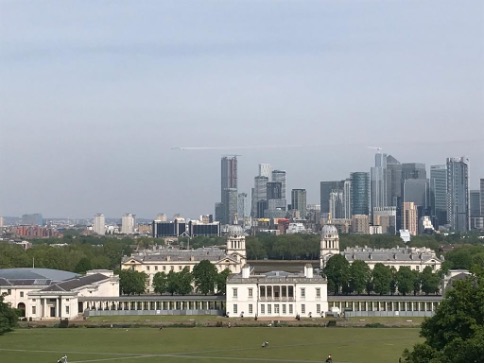 The Royal Naval College in Greenwich was built on the site of the Palace of Placentia, where Henry VIII married first Catherine of Aragon and later, after his break with the Catholic Church, Anne Boleyn. Elizabeth I was born at the Palace and spent much of her childhood there. Little remains of the palace today, except as some of the foundations to the current buildings. The area has changed significantly since Elizabeth’s day but the royal hunting grounds to the south of the palace remain as Greenwich Park.
The Royal Naval College in Greenwich was built on the site of the Palace of Placentia, where Henry VIII married first Catherine of Aragon and later, after his break with the Catholic Church, Anne Boleyn. Elizabeth I was born at the Palace and spent much of her childhood there. Little remains of the palace today, except as some of the foundations to the current buildings. The area has changed significantly since Elizabeth’s day but the royal hunting grounds to the south of the palace remain as Greenwich Park.
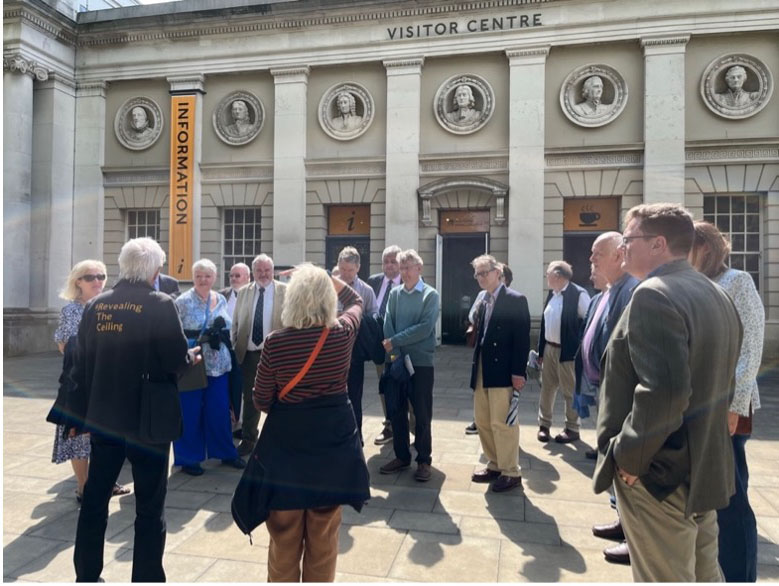
Twenty-three intrepid Tylers and Bricklayers, their guests and the Clerk met at the Visitors’ centre at the Royal Naval College, braving the uncertainty of public transport on a rail and tube strike day. The weather, which had been very changeable all week, turned out to be kind and it was dry and warm for our walking tour of the site.
The College is a magnificent example of Sir Christopher Wren’s architecture and it was timely to visit during the 300th anniversary year of his death at the age of 90.
Roger, our guide, gave us a most informative and entertaining tour of the site, which for many years was home to retired sailors, much like the Chelsea Hospital for soldiers. From what we heard, the sailors mostly sought their entertainment in the local town, which was well provided with all the facilities found in a busy port of the time.
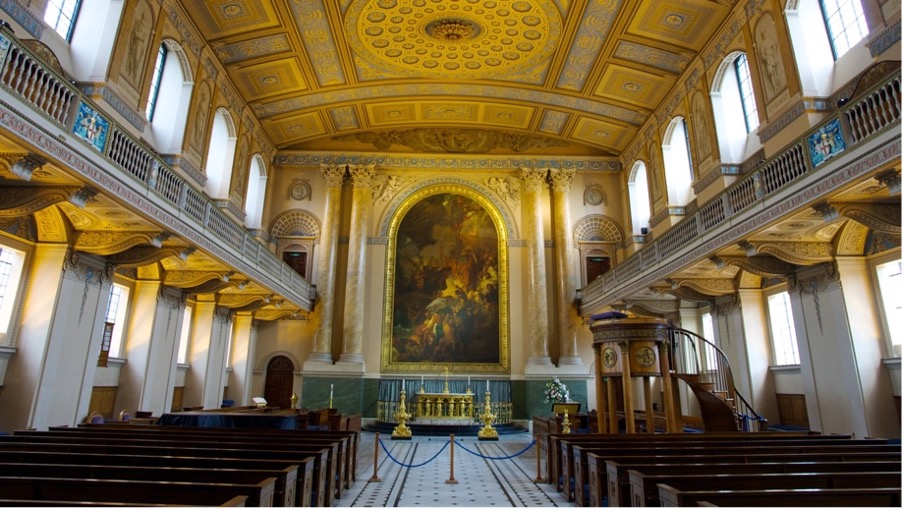 After walking around the College buildings site, which is much used as a film set these days, we entered the Chapel of St Peter & St Paul. This very restful but grand space is still available for weddings, so we were lucky to be able to enjoy it briefly. It was part Sir Christopher Wren’s original design for the Royal Hospital for Seamen at Greenwich, and after a devastating fire, the Chapel was rebuilt in 1779 by James ‘Athenian’ Stuart. With a richly decorated ceiling depicting naval themes, and an altarpiece painted by Benjamin West, it is now regarded as one of the finest neo-classical interiors in existence.
After walking around the College buildings site, which is much used as a film set these days, we entered the Chapel of St Peter & St Paul. This very restful but grand space is still available for weddings, so we were lucky to be able to enjoy it briefly. It was part Sir Christopher Wren’s original design for the Royal Hospital for Seamen at Greenwich, and after a devastating fire, the Chapel was rebuilt in 1779 by James ‘Athenian’ Stuart. With a richly decorated ceiling depicting naval themes, and an altarpiece painted by Benjamin West, it is now regarded as one of the finest neo-classical interiors in existence.
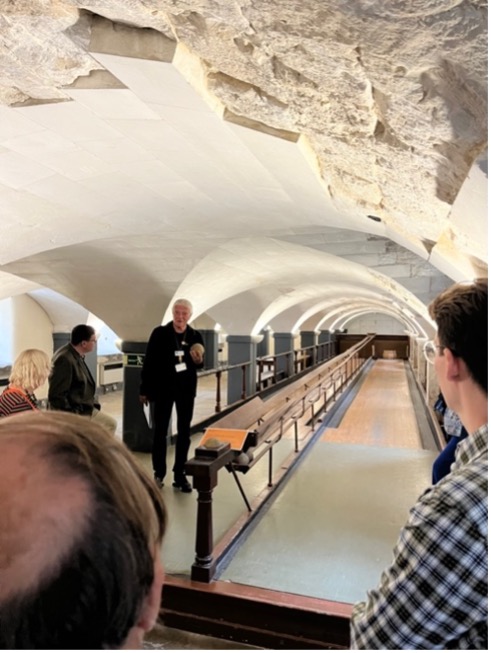 On-site entertainment was limited in years gone by, and we visited the main attraction during Victorian times – a basement bowling alley, not normally open to the public. Here the seamen smoked and chatted, bowling with heavy cannon balls. There were no automatic systems to re-set the skittles!
On-site entertainment was limited in years gone by, and we visited the main attraction during Victorian times – a basement bowling alley, not normally open to the public. Here the seamen smoked and chatted, bowling with heavy cannon balls. There were no automatic systems to re-set the skittles!
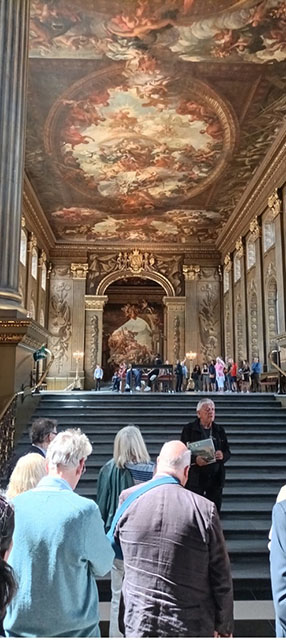 Our tour of the site concluded in the magnificent Painted Hall, with its amazing painted walls and ceilings undertaken by Sir James Thornhill. These are are covered in images depicting over two hundred figures including kings, queens and mythological creatures. It is the largest painted ceiling in the country. The hall has recently undergone an extensive conservation programme returning it to its former glory and it was fascinating to hear about all the imagery contained within the paintings. Roger brought it all to life and it must have been an astonishing venue for dining in the days when the College was used for training officers for the Royal Navy.
Our tour of the site concluded in the magnificent Painted Hall, with its amazing painted walls and ceilings undertaken by Sir James Thornhill. These are are covered in images depicting over two hundred figures including kings, queens and mythological creatures. It is the largest painted ceiling in the country. The hall has recently undergone an extensive conservation programme returning it to its former glory and it was fascinating to hear about all the imagery contained within the paintings. Roger brought it all to life and it must have been an astonishing venue for dining in the days when the College was used for training officers for the Royal Navy.
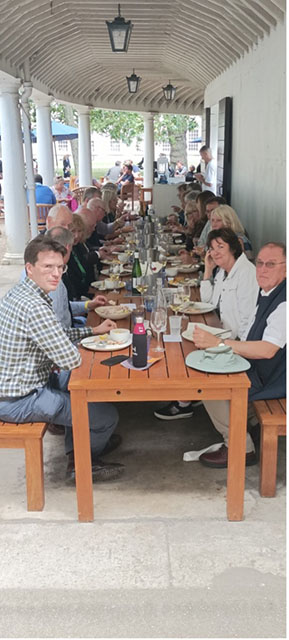
On this occasion, we were not to dine in the Painted Hall, but after two hours on our feet everyone was ready for lunch at the Old Brewery overlooking the river. We enjoyed a three-course lunch with wine under the colonnade, with both fine company and fine weather.
After this long lunch, some departed to ensure that they were able to get home before the public transport closed down. A small group made their way up the hill to the Royal Observatory to view the exhibition there. We stopped to marvel at the view across the park over the Queens House and Royal Maritime Museum with the Royal Naval College and river beyond. St Pauls Cathedral is just visible in the distance, one of the preserved views in London. The view across to Canary Wharf and the City of London has undoubtedly changed considerably over the years since Elizabeth I was a child, with less river traffic, cleaner water and less smoke! However, the contour of the river and the green expanse of Greenwich Park have remained the same, although now with the screeching of many parakeets and without any deer!
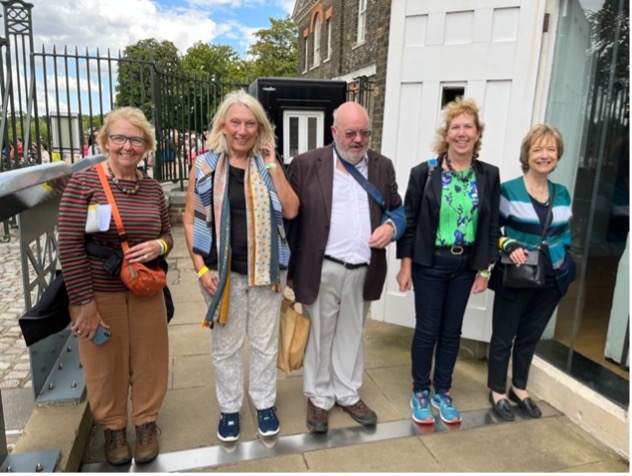
The Royal Observatory was built reusing bricks from the palace of Placentia and is a landmark visible for miles across London. The meridian line runs through the building, representing the Prime Meridian of the world, Longitude Zero, seen as a steel strip in the photograph above.
The Observatory houses a magnificent collection of telescopes and clocks, including John Harrison’s timepieces which won the Longitude Prize of £20,000. This was a huge sum of money, equivalent to £1.5 million today, which the government was reluctant to pay.
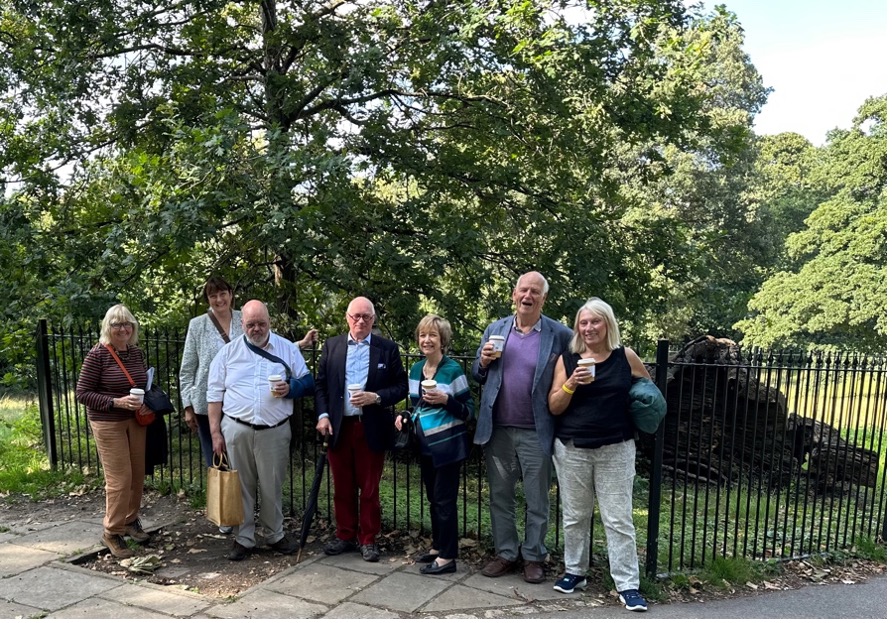
Charter day concluded with tea at the Observatory and a visit to Queen Elizabeth’s Oak. The Oak, which is thought to date from the 12th century, was a place where Elizabeth is reputed to have spent many childhood hours. It died at the end of the 19th century but remained standing for many years because of ivy holding it up. It eventually fell in 1991 and all that remains is the rotting trunk, home to insects and fungi. A replacement tree was planted by the late Duke of Edinburgh. Long may it flourish, root and branch!
The Master and Mistress, see here with friends by Queen Elizabeth’s Oak, were delighted that so many members of the Company were able to join them.
The Mistress - Dr Helen Schofield
